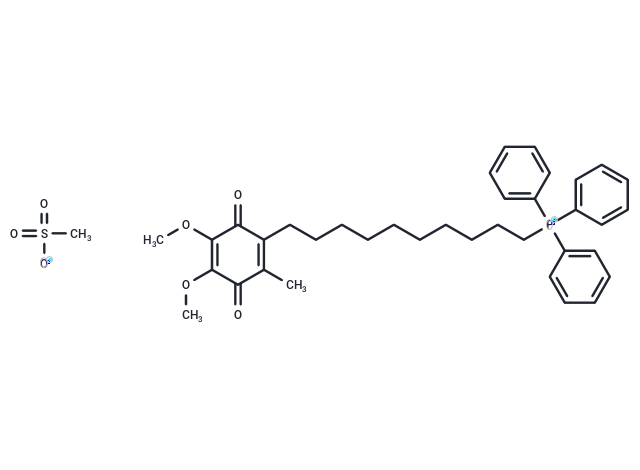Shopping Cart
- Remove All
 Your shopping cart is currently empty
Your shopping cart is currently empty

Mitoquinone mesylate (MitoQ10 mesylate) is a TPP-based, mitochondrially targeted antioxidant to protect against oxidative damage.

| Pack Size | Price | Availability | Quantity |
|---|---|---|---|
| 1 mg | $31 | In Stock | |
| 5 mg | $72 | In Stock | |
| 10 mg | $113 | In Stock | |
| 25 mg | $228 | In Stock | |
| 50 mg | $372 | In Stock | |
| 100 mg | $549 | In Stock | |
| 500 mg | Inquiry | In Stock | |
| 1 mL x 10 mM (in DMSO) | $109 | In Stock |
| Description | Mitoquinone mesylate (MitoQ10 mesylate) is a TPP-based, mitochondrially targeted antioxidant to protect against oxidative damage. |
| In vitro | Normal rat kidney (NRK) cells exposed to CS result in a ~2-fold increase in fluorescence due to mitochondrial superoxide compared with untreated cells. Mitoquinone offers significant protection against CS-induced mitochondrial superoxide generation[1]. |
| In vivo | Mitoquinone (MitoQ) treatment nearly doubles lung MPO activity induced by Caerulein with a significant increase of serum IL-6 levels also evident at 10?mg/kg (dose 1)[2]. |
| Alias | MitoQ10 mesylate, MitoQ mesylate |
| Molecular Weight | 678.81 |
| Formula | C38H47O7PS |
| Cas No. | 845959-50-4 |
| Smiles | [O-]S(=O)(C)=O.O=C(C(CCCCCCCCCC[P+](C1=CC=CC=C1)(C2=CC=CC=C2)C3=CC=CC=C3)=C4C)C(OC)=C(OC)C4=O |
| Relative Density. | no data available |
| Storage | store at low temperature | Powder: -20°C for 3 years | In solvent: -80°C for 1 year | Shipping with blue ice. | |||||||||||||||||||||||||||||||||||
| Solubility Information | DMSO: 50 mg/mL (73.66 mM), Sonication is recommended. H2O: 10 mg/mL (14.73 mM), Sonication is recommended. | |||||||||||||||||||||||||||||||||||
Solution Preparation Table | ||||||||||||||||||||||||||||||||||||
H2O/DMSO
DMSO
| ||||||||||||||||||||||||||||||||||||

Copyright © 2015-2025 TargetMol Chemicals Inc. All Rights Reserved.